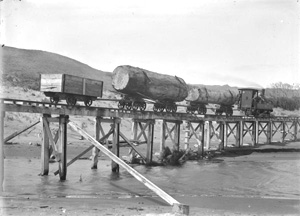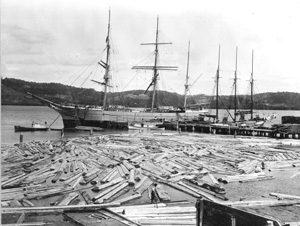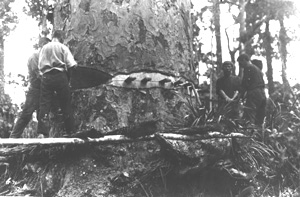|
The magnificent kauri forests that once covered 1.6 million hectares (4 million acres)
of the northern half of the North Island, were destroyed by logging, fire and clearing
for farming to leave about 7,000 hectares (18,000 acres) of remnants, mainly in the
Waipoua forests in Northland, and State forest on the Coromandel Peninsula.
Most of the kauri timber was extracted during the 19th century. Before the turn of
the century, kauri was milled at an average rate of 236,000 cubic metres a year. The
rate of production after a final ten-year boom period in the late 19th and early 20th
century declined to an annual average of 3000 cubic metres.
It took another 70 years of kauri logging before realisation of the dwindled resource,
and a growing public sentiment to save the forest, caused government policy to be
established for protection in 1973. This was the first protective legislation
for an indigenous tree in New Zealand. |

|
Starting in about 1830, after three decades of removing small trees, pit sawyers moved
into the forests to cut logs into boards for local and export markets. Kauri rapidly
became the preferred timber for house construction, furniture, and boatbuilding. The wood
is soft, but strong and durable, with an even straight grain free of knots. Kauri is
so easy to work that it is possible to plane against the grain.
Sawmills were first established in the late 1830's, and soon there were numerous small
mills powered initially by water wheels, and then later with steam, cutting logs from
kauri forests around the sheltered harbours of Northland, Auckland and the Coromandel
Peninsula.
Industry expansion was in excess of demand in the 1880s causing many mills to declare
bankruptcy. The Kauri Timber Company was formed in 1888 by a group of financiers in
Melbourne, Australia, and quickly gained a monopoly of the kauri industry by the takeover
of a number of the distressed milling companies. It owned and operated as many as
thirty mills at one time, and shipped kauri to Australia and the west coast of the United
States.
With the depletion of kauri resources, the company diversified operations
into other timbers, by taking over other milling companies including White Pine Company
in 1902, Ellis and Burnand in 1904, and Butler Brothers in 1907. In 1961 the Kauri
Timber Company was itself taken over by Fletcher Timber Ltd, which is today New Zealand's
second largest forestry company, operating in a number of countries.
The depressed state of the kauri industry continued until 1897, by which time 75 percent
of the kauri forests had been cut. Production then increased in a final great boom
period that reached a peak in 1907. From thereon kauri production declined, and minor
quantities were milled from 1920 until 1973 when kauri became protected. The supply of logs
from private land had almost ceased in the late 1950s and early 1960s, but continued from
State forests. |
|

|
New Zealand's first export trade ...
Kauri timber was the first New Zealand natural resource to be extracted by Europeans,
and the first export. The first recorded kauri cut was at Manawaroa Bay in the
Bay of Islands by Marion du Fresne in 1772, for his ship's foremast.
The export trade commenced when the British Royal Navy ship 'Fancy' took 200 trees for
spars from Doubtless Bay in Northland and the Coromandel Coast in 1794, 25 years after
Captain James Cook's rediscovery of New Zealand in 1769. Merchants from Sydney
in the newly settled New South Wales colony, and British Navy merchants were actively
trading at the turn of the 19th century. At first, with access only from the coast,
relatively young, straight trees were cut that were ideal as masts and spars for
sailing ships.
European trading ships started entering the Kaipara Harbour about 1838 to trade for
timber. Kaipara contains the largest area of water of any harbour in the world,
but it is now closed to shipping. At the peak of timber trading it was the busiest
harbour in New Zealand, with as many as 26 ships leaving on a high tide during
the day, loaded with kauri timber from mills around the shores of the harbour and the
Wairoa River. |

About 3000 kauri dams were built in New Zealand in the 19th century and early 20th century.
Called driving dams, they were built to transport large quantities of logs downstream from
unroaded areas. They played a significant part in the destruction of the forest, in
making the removal of trees from inaccessible areas possible, and in the forest damage and
soil erosion caused by the massive surge of logs and water.
Even so, it is difficult not to recognise the impressive feats in building them
without engineering drawings or calculations. The kauri dams withstood the pressure
of tons of water, and a massive force of logs and water surging through them when the dam
was tripped. Many kauri dams are still in place today.
Kauri was also highly valued for its gum, used in the production of high quality
paints and varnishes, linoleum, and jewelry. Gum was extracted from ground at the
base, and "bled" from the trunk, which caused the early death of many trees. When gum
became harder to find, gum diggers hand excavated gum from old buried forests. |
|








